Experimental Evaluation of Low Velocity Impact Properties and Damage Progression on Bamboo/Glass Hybrid Composites Subjected to Different Impact Energy Levels
Abstract
1. Introduction
2. Experimental Section
2.1. Materials
2.2. Composite Fabrication
2.3. Characterisation of Impact Properties
2.4. Characterisation of Impact Damages
3. Results and Discussion
3.1. Force Displacement Analysis
3.2. Peak Force Variation with Impact Energy
3.3. Energy Absorbed Variation with Impact Energy
3.4. Damage Analysis on The Impacted Samples
4. Conclusions
Author Contributions
Funding
Acknowledgments
Conflicts of Interest
References
- Salman, S.D.; Leman, Z.; Sultan, M.; Ishak, M.R.; Cardona, F. The Effects of Orientation on the Mechanical and Morphological Properties of Woven Kenaf-reinforced Poly Vinyl Butyral Film. Bioresources 2015, 11, 1176–1188. [Google Scholar] [CrossRef]
- Mao, C.; Zhang, C. Numerical analysis of influence factors on low-velocity impact damage of stitched composite laminates. Mech. Adv. Mater. Struct. 2018, 1–10. [Google Scholar] [CrossRef]
- Salman, S.D.; Leman, Z.; Sultan, M.T.H.; Ishak, M.R.; Cardona, F. Effect of kenaf fibers on trauma penetration depth and ballistic impact resistance for laminated composites. Text. Res. J. 2016, 87, 1–15. [Google Scholar] [CrossRef]
- Srivastava, V.K. Impact Behaviour of Sandwich GFRP-Foam-GFRP Composites. Int. J. Compos. Mater. 2012, 2, 63–66. [Google Scholar] [CrossRef]
- Safri, S.N.A.; Sultan, M.T.H.; Yidris, N.; Mustapha, F. Low velocity and high velocity impact test on composite materials—A review. Int. J. Eng. Sci. 2014, 3, 50–60. [Google Scholar]
- Nor, A.F.M.; Sultan, M.T.H.; Jawaid, M.; Azmi, A.M.R.; Shah, A.U.M. Analysing impact properties of CNT filled bamboo/glass hybrid nanocomposites through drop-weight impact testing, UWPI and compression-after-impact behavior. Compos. Part B 2019, 168, 166–174. [Google Scholar] [CrossRef]
- Spronk, S.W.F.; Kersemans, M.; De Baerdemaeker, J.C.A.; Gilabert, F.A.; Sevenois, R.D.B.; Garoz, D.; Kassapoglou, C.; Paepegem, W.V. Comparing damage from low-velocity impact and quasi-static indentation in automotive carbon/epoxy and glass/polyamide-6 laminates. Polym. Test. 2018, 65, 231–241. [Google Scholar] [CrossRef]
- Mostafa, N.H.; Ismarrubie, Z.N.; Sapuan, S.M.; Sultan, M.T.H. Fibre prestressed composites: Theoretical and numerical modelling of unidirectional and plain-weave fibre reinforcement forms. Compos. Struct. 2017, 159, 410–423. [Google Scholar] [CrossRef]
- Caminero, M.A.; Garcia-Moreno, I.; Rodriguez, G.P. Damage resistance of carbon fibre reinforced epoxy laminates subjected to low velocity impact: Effects of laminate thickness and ply-stacking sequence. Polym. Test. 2017, 63, 530–541. [Google Scholar] [CrossRef]
- Caminero, M.A.; Garcia-Moreno, I.; Rodriguez, G.P. Experimental study of the influence of thickness and ply-stacking sequence on the compression after impact strength of carbon fibre reinforced epoxy laminates. Polym. Test. 2018, 66, 360–370. [Google Scholar] [CrossRef]
- Safri, S.N.A.; Sultan, M.T.H.; Jawaid, M.; Majid, M.S. Analysis of dynamic mechanical, low velocity impact and compression after impact behavior of benzoyl treated sugar palm/glass/epoxy composites. Compos. Struct. 2019, 226, 111308. [Google Scholar] [CrossRef]
- Ravandi, M.; Teo, W.S.; Tran, L.Q.N.; Yong, M.S.; Tay, T.E. Low velocity impact performance of stitched flax/epoxy composite laminates. Compos. Part B 2017, 117, 89–100. [Google Scholar] [CrossRef]
- Zakikhani, P.; Zahari, R.; Sultan, M.T.H.; Majid, D.L.A.A. Thermal degradation of four bamboo species. Bioresources 2016, 11, 414–425. [Google Scholar] [CrossRef]
- Zakikhani, P.; Zahari, R.; Sultan, M.T.H.; Majid, D.L. Extraction and preparation of bamboo fibre-reinforced composites. Mater. Des. 2014, 63, 820–828. [Google Scholar] [CrossRef]
- Bahari, S.A.; Krause, A. Utilizing Malaysian bamboo for use in thermoplastic composites. J. Clean. Prod. 2016, 110, 16–24. [Google Scholar] [CrossRef]
- Haddou, G.; Dandurand, J.; Dantras, E.; Maiduc, H.; Thai, H.; Giang, N.V.; Trung, T.H.; Ponteins, P.; Lacabanne, C. Physical structure and mechanical properties of polyamide/bamboo composites. J. Therm. Anal. Calorim. 2017, 129, 1463–1469. [Google Scholar] [CrossRef]
- Kumar, N.; Mireja, S.; Khandelwal, V.; Arun, B.; Manik, G. Light-weight high-strength hollow glass microsphere and bamboo fiber based hybrid polypropylene composite: A strength analysis and morphological study. Compos. Part B 2017, 109, 277–285. [Google Scholar] [CrossRef]
- Shah, A.U.M.; Sultan, M.T.H.; Jawaid, M. Sandwich-structured bamboo powder/glass fibre-reinforced epoxy hybrid composites—Mechanical performance in static and dynamic evaluations. J. Sandw. Struct. Mater. 2019, 1–18. [Google Scholar] [CrossRef]
- Shah, A.U.M.; Sultan, M.T.H.; Cardona, F.; Jawaid, M.; Talib, A.R.A.; Yidris, N. Thermal analysis of bamboo fibre and its composites. Bioresources 2017, 12, 2394–2406. [Google Scholar]
- Safri, S.N.A.; Sultan, M.T.H.; Aminanda, Y. Impact characterization of glass fibre reinforced polymer (GFRP) type C-600 and E-800 using a drop weight machine. Appl. Mech. Mater. 2017, 629, 461–466. [Google Scholar] [CrossRef]
- Naebe, M.; Abolhasani, M.M.; Khayyam, H.; Amini, A.; Fox, B. Crack damage in polymers and composites: A review. Polym. Rev. 2016, 56, 31–69. [Google Scholar] [CrossRef]
- Simeoli, G.; Acierno, D.; Meola, C.; Sorrentino, L.; Iannace, S.; Russo, P. The role of interface strength on the low velocity impact behavior of PP/glass fibre laminates. Compos. Part B 2014, 62, 88–96. [Google Scholar] [CrossRef]
- Ismail, K.I.; Sultan, M.T.H.; Shah, A.U.M.; Jawaid, M.; Safri, S.N.A. Low velocity impact and compression after impact properties of hybrid bio-composites modified with multi-walled carbon nanotubes. Compos. Part B 2019, 163, 455–463. [Google Scholar] [CrossRef]
- Ahmad, F.; Hong, J.W.; Choi, H.S.; Park, S.J.; Park, M.K. The effects of stacking sequence on the penetration-resistant behaviours of T800 carbon fiber composite plates under low velocity impact loading. Carbon Lett. 2015, 16, 107–115. [Google Scholar] [CrossRef]
- Safri, S.N.A.; Chan, T.Y.; Sultan, M.T.H. An experimental study of low velocity impact (LVI) on fibre glass reinforced polymer (FGRP). Int. J. Eng. Sci. 2014, 3, 1–10. [Google Scholar]
- Hung, P.; Lau, K.; Cheng, L.; Leng, J.; Hui, D. Impact response of hybrid carbon/glass fibre reinforced polymer composites designed for engineering applications. Compos. Part B 2018, 133, 86–90. [Google Scholar] [CrossRef]
- Zivkovic, I.; Fragassa, C.; Pavlovic, A.; Brugo, T. Influence of moisture absorption on the impact properties of flax, basalt and hybrid flax/basalt fiber reinforced green composites. Compos. Part B 2017, 111, 148–164. [Google Scholar] [CrossRef]



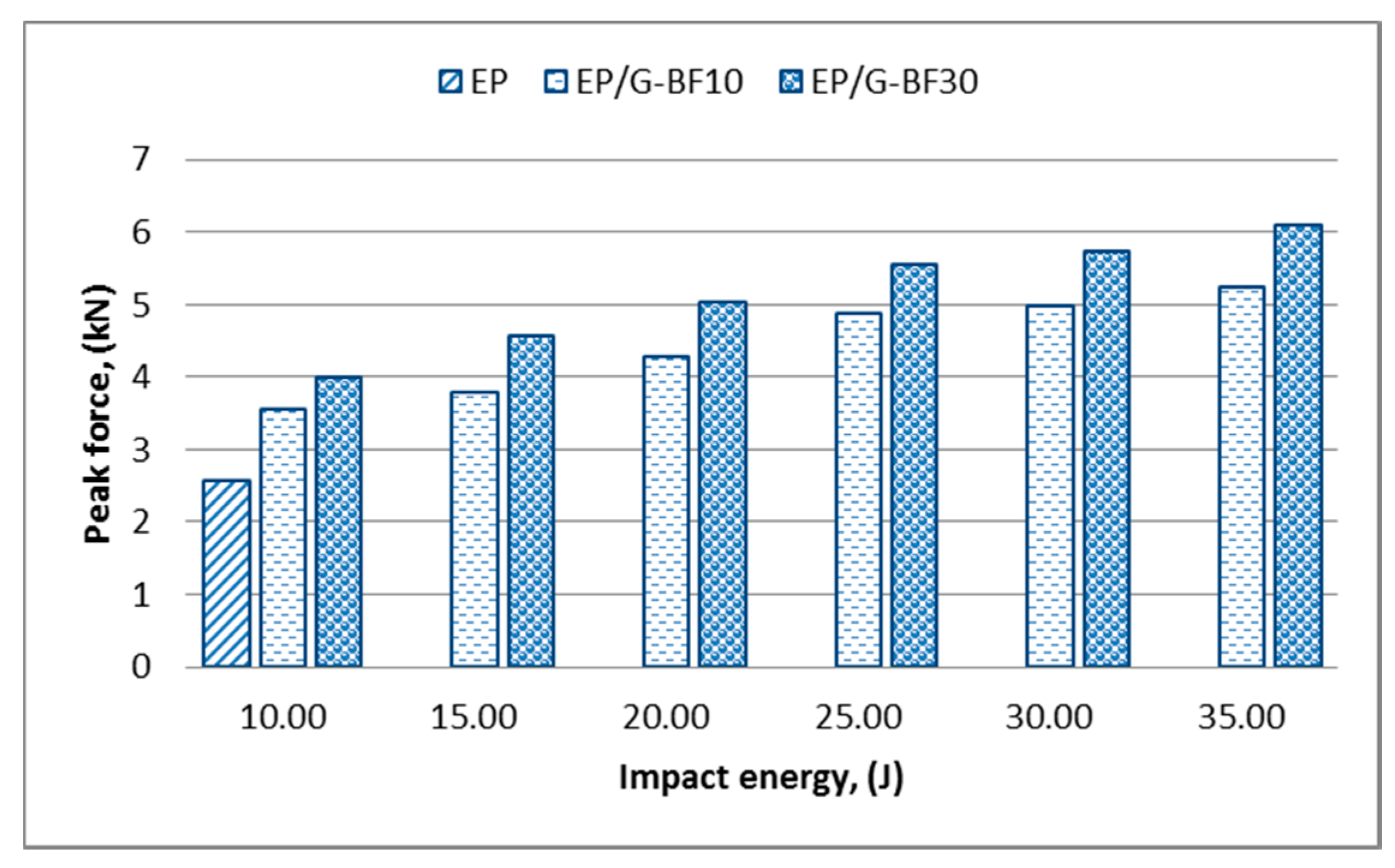

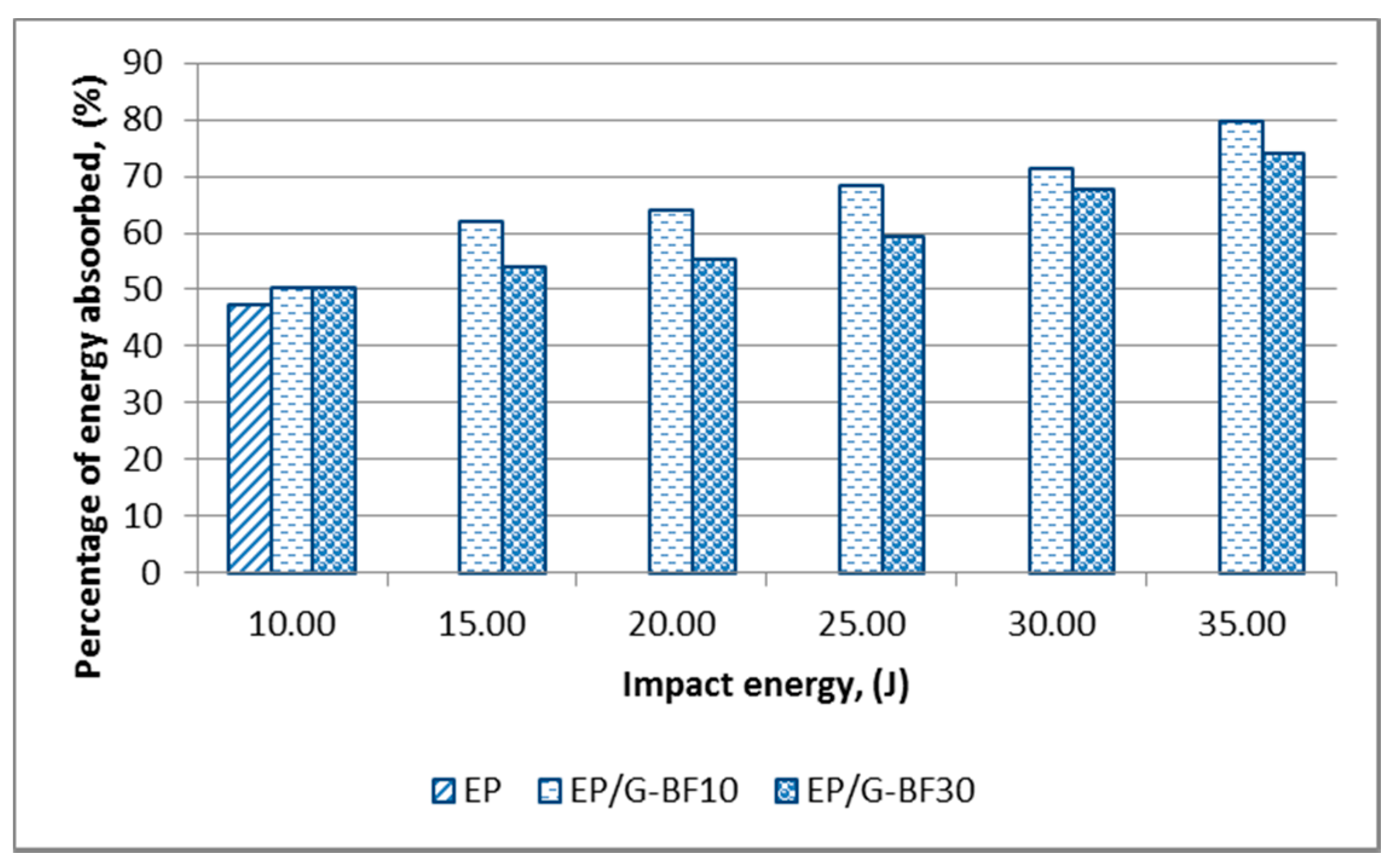



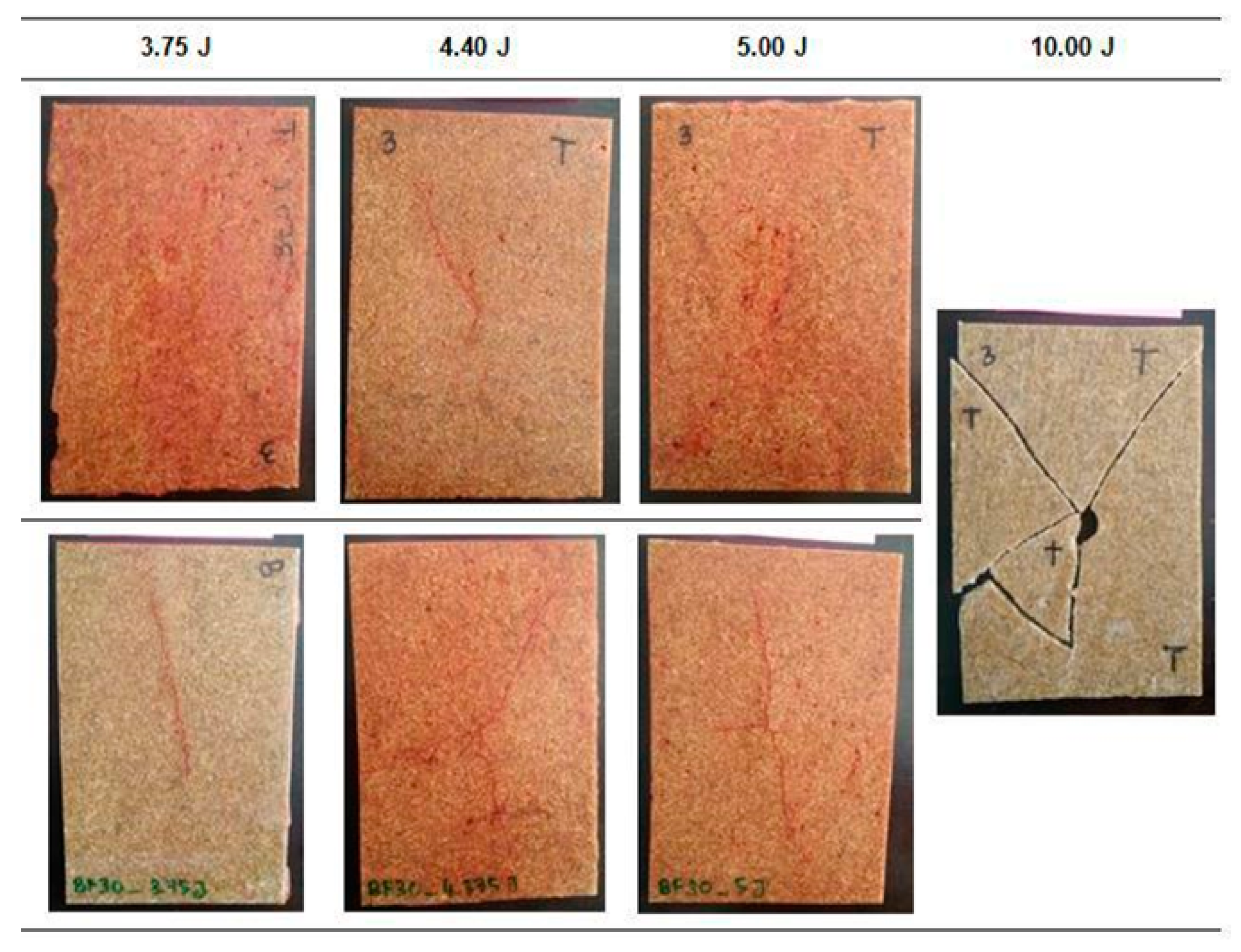
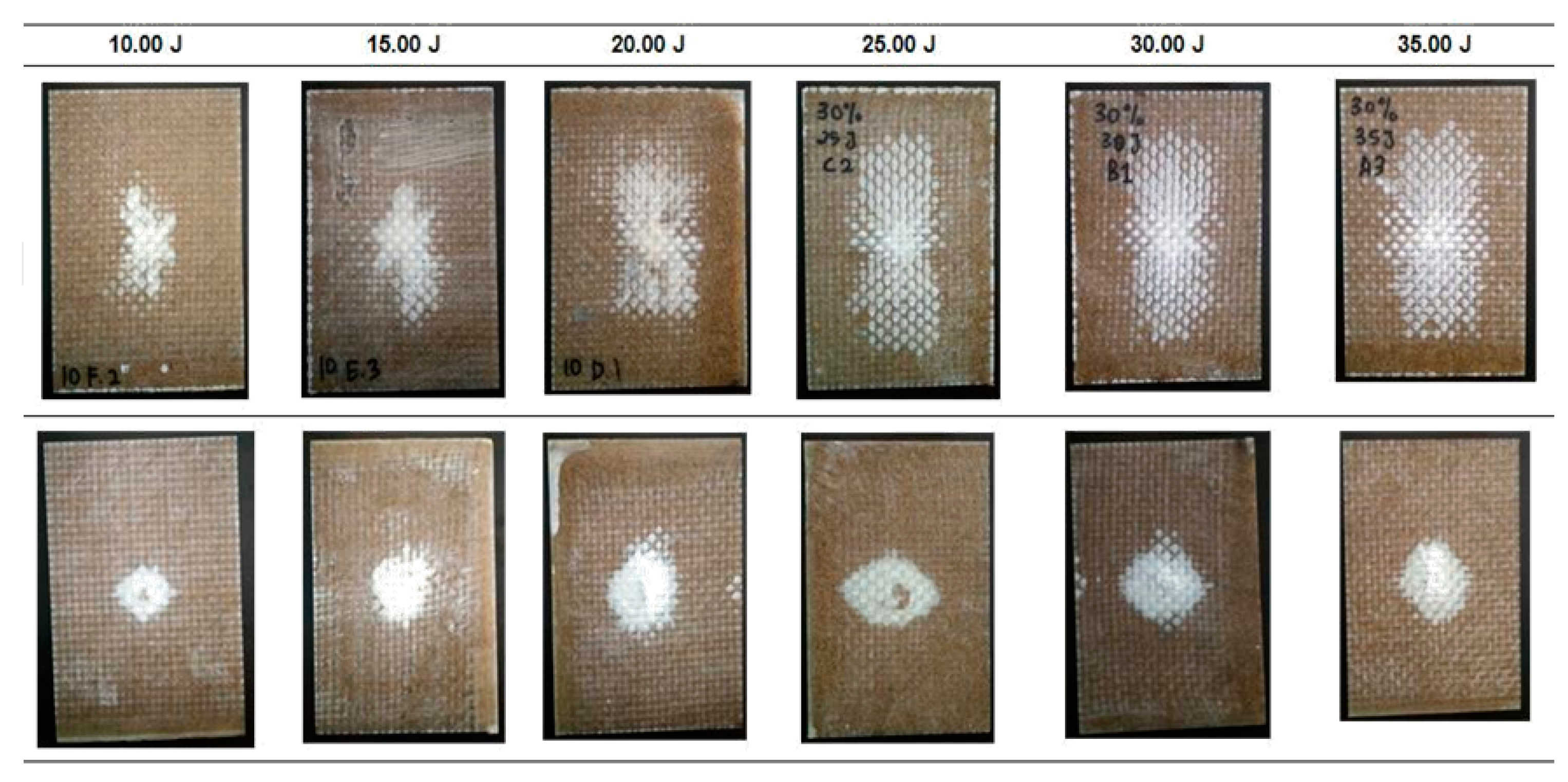
| Materials | Epoxy Matrix | E-Glass Fibre |
|---|---|---|
| Density (g/cm3) | 1.10 | 2.58 |
| Tensile Strength (MPa) | 54 | 3445 |
| Tensile Modulus (GPa) | 3.2 | 72.3 |
| Composites | EP and EP-BF Composites | EP/G-BF Composites | |||||||||
|---|---|---|---|---|---|---|---|---|---|---|---|
| Impact Energy (J) | 2.50 | 3.75 | 4.40 | 5.0 | 10.0 | 10.0 | 15.0 | 20.0 | 25.0 | 30.0 | 35.0 |
| Sample | Impact Energy (J) | Peak Force (kN) | Energy Absorbed (J) | Peak Deformation (mm) |
|---|---|---|---|---|
| EP | 2.50 | 1.31 (0.03) | 0.85 (0.01) | 4.16 (0.05) |
| 3.75 | 1.46 (0.02) | 1.35 (0.02) | 5.19 (0.05) | |
| 4.40 | 1.57 (0.02) | 1.61 (0.02) | 5.51 (0.05) | |
| 5.00 | 1.78 (0.03) | 1.78 (0.03) | 5.45 (0.03) | |
| 10.00 | 2.57 (0.02) | 4.72 (0.04) | 7.23 (0.05) | |
| EP-BF10 | 2.50 | 1.14 (0.01) | 2.12 (0.04) | 4.88 (0.03) |
| 3.75 | 0.65 (0.02) | 3.32 (0.03) | 9.22 (0.04) | |
| 4.40 | 1.02 (0.04) | 2.70 (0.03) | 6.94 (0.04) | |
| 5.00 | - | - | - | |
| 10.00 | - | - | - | |
| EP-BF30 | 2.50 | 0.91 (0.02) | 1.76 (0.03) | 3.99 (0.02) |
| 3.75 | 1.42 (0.03) | 2.39 (0.05) | 3.99 (0.03) | |
| 4.40 | 0.98 (0.02) | 2.95 (0.02) | 6.43 (0.02) | |
| 5.00 | 1.11 (0.02) | 3.21 (0.02) | 5.93 (0.05) | |
| 10.00 | - | - | - |
| Sample | Impact Energy (J) | Peak Force (kN) | Energy Absorbed (J) | Peak Deformation (mm) |
|---|---|---|---|---|
| EP/G-BF10 | 10 | 3.54 (0.04) | 5.01 (0.03) | 4.91 (0.04) |
| 15 | 3.78 (0.05) | 9.29 (0.04) | 6.41 (0.5) | |
| 20 | 4.28 (0.05) | 12.80 (0.07) | 7.63 (0.05) | |
| 25 | 4.87 (0.06) | 17.05 (0.07) | 8.53 (0.04) | |
| 30 | 4.97 (0.05) | 21.42 (0.07) | 9.87 (0.05) | |
| 35 | 5.24 (0.04) | 27.92 (0.05) | 11.32 (0.07) | |
| EP/G-BF30 | 10 | 3.99 (0.03) | 5.02 (0.05) | 4.01 (0.05) |
| 15 | 4.55 (0.06) | 8.10 (0.05) | 4.89 (0.05) | |
| 20 | 5.04 (0.05) | 11.03 (0.04) | 5.97 (0.04) | |
| 25 | 5.55 (0.04) | 14.85 (0.07) | 6.63 (0.04) | |
| 30 | 5.73 (0.05) | 20.26 (0.05) | 7.83 (0.06) | |
| 35 | 6.10 (0.05) | 25.87 (0.08) | 8.96 (0.08) |
| Energy Levels (J) | 2.50 | 3.75 | 4.40 | 5.00 |
| Distance (mm) | 53 | 61 | 70 | break |
| Energy Levels (J) | 2.50 | 3.75 | 4.40 | 5.00 | 10.00 |
| Distance (mm) | 27 | 40 | 59 | 63 | break |
| Energy Levels (J) | 10 | 15 | 20 | 25 | 30 | 35 | |
| Area (mm2) | EP/G-BF10 | 730 | 1700 | 3800 | 5500 | 5500 | 5600 |
| EP/G-BF30 | 300 | 700 | 1760 | 4000 | 3300 | 1000 | |
© 2020 by the authors. Licensee MDPI, Basel, Switzerland. This article is an open access article distributed under the terms and conditions of the Creative Commons Attribution (CC BY) license (http://creativecommons.org/licenses/by/4.0/).
Share and Cite
Md Shah, A.U.; Hameed Sultan, M.T.; Safri, S.N.A. Experimental Evaluation of Low Velocity Impact Properties and Damage Progression on Bamboo/Glass Hybrid Composites Subjected to Different Impact Energy Levels. Polymers 2020, 12, 1288. https://doi.org/10.3390/polym12061288
Md Shah AU, Hameed Sultan MT, Safri SNA. Experimental Evaluation of Low Velocity Impact Properties and Damage Progression on Bamboo/Glass Hybrid Composites Subjected to Different Impact Energy Levels. Polymers. 2020; 12(6):1288. https://doi.org/10.3390/polym12061288
Chicago/Turabian StyleMd Shah, Ain Umaira, Mohamed Thariq Hameed Sultan, and Syafiqah Nur Azrie Safri. 2020. "Experimental Evaluation of Low Velocity Impact Properties and Damage Progression on Bamboo/Glass Hybrid Composites Subjected to Different Impact Energy Levels" Polymers 12, no. 6: 1288. https://doi.org/10.3390/polym12061288
APA StyleMd Shah, A. U., Hameed Sultan, M. T., & Safri, S. N. A. (2020). Experimental Evaluation of Low Velocity Impact Properties and Damage Progression on Bamboo/Glass Hybrid Composites Subjected to Different Impact Energy Levels. Polymers, 12(6), 1288. https://doi.org/10.3390/polym12061288







